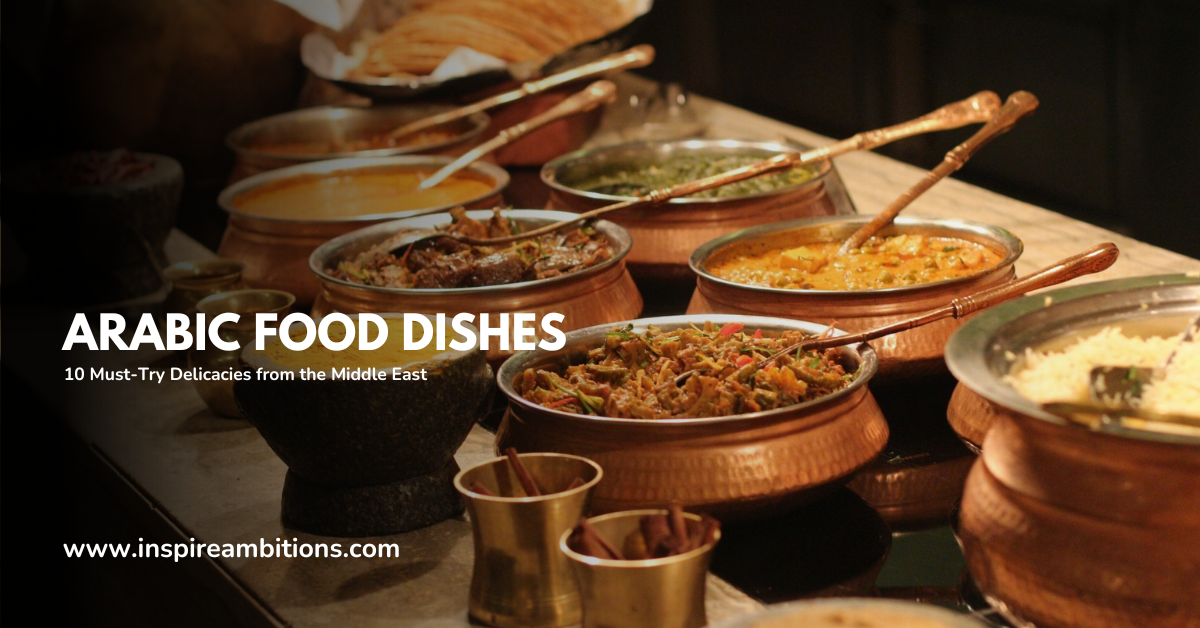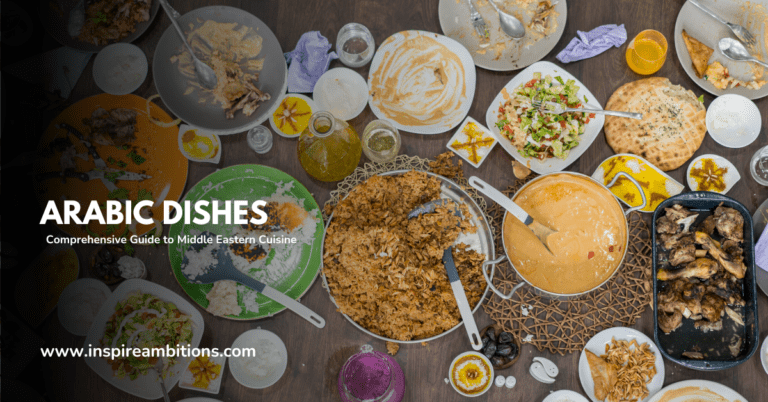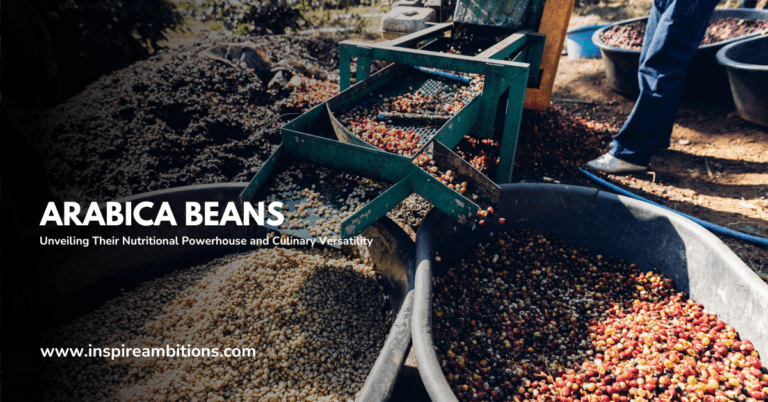Arabic Food Dishes – 10 Must-Try Delicacies from the Middle East
Arabic cuisine is a diverse, flavourful, and rich culinary experience with a history spanning thousands of years. Throughout the Middle East and the Arabian Peninsula, the dishes have evolved and adapted with local influences, creating an array of unique flavours.
In this article, we will explore a selection of mouth-watering Arabic dishes that you should try.
From appetisers and salads to main courses and desserts, Arabic cuisine offers something for every palate. The use of a variety of spices, such as baharat and ras el hanout, lends depth to the flavours, while ingredients like chickpeas, lentils, and an assortment of vegetables and meats provide a medley of textures.
One popular and versatile Arabic dish is hummus, a chickpea-based dip flavoured with garlic, tahini, and lemon juice. Another delectable treat is kabsa, a combination of rice, meat, and spices commonly enjoyed in Saudi Arabia.
Whether you’re dining in a Middle Eastern restaurant or trying your hand at cooking these dishes at home, the vibrant flavours and aromas of Arabic cuisine are sure to captivate your senses.
History of Arabic Food
The history of Arabic food dates back to the ancient civilisations of the Middle East, where the Sumerians, Babylonians, Phoenicians or Canaanites, Hittites, Arameans, Assyrians, Egyptians, and Nabateans all contributed to the formation of the Arabic kitchen.
As you delve into the roots of this cuisine, you’ll find a rich tapestry of flavours and influences that have shaped and refined what we know today as Arabic food.
In the 7th century, when the Arabs arrived on the shores of the eastern Mediterranean and occupied North Africa, they found a wide variety of foods. Some of these culinary elements had ancient origins, going back to the beginning of civilised history.
The Arabs incorporated local ingredients and cooking methods into their cuisine, enriching it even further.
Arabic cuisine offers a diverse range of dishes, from mezze or small plates like tabouleh to dips like hummus, baba ganoush, and labneh. Each region and country has its specific dishes and culinary traditions.
For example, Lebanon has a longstanding reputation for its delicious raw meat dishes, while Algeria is known for couscous, a dish steeped in historical significance.
As you explore the vast array of Arabic dishes, it’s important to note the interplay between the food, culture, and history of the region.
This interwoven relationship allows you to appreciate the depth, complexity, and subtleties of Arabic cuisine holistically.
Remember, the history of Arabic cuisine is diverse and rich. The more you discover about it, the greater your understanding and appreciation of this culinary masterpiece will be.
Prominent Ingredients in Arabic Cuisine
Arabic cuisine is rich, diverse, and flavourful, spanning different regions and cultures throughout the Middle East and North Africa.
As you explore this culinary tradition, you’ll discover an array of prominent ingredients that serve as the foundation of many dishes. Here are some key ingredients you’ll find in Arabic cuisine:
Chickpeas play a central role in many dishes you’ll encounter in Arabic cuisine, most notably in hummus. When blended with garlic, lemon juice, and olive oil, chickpeas become a beloved and versatile staple throughout the Middle East.
Couscous and rice are other pivotal ingredients in Arabic dishes. These grains are used to create filling and comforting dishes that are enjoyed by families across the Arab world. While couscous prevails in the Maghreb, rice is more prevalent in the Mashreq.
When it comes to spices, Arabic cuisine boasts a wide variety of bold and fragrant flavours. Baharat, a blend of spices like nutmeg, cardamom, coriander, paprika, black pepper, cinnamon, cumin, and cloves, is widely used across the Middle East and the Arabian Peninsula.
Another iconic spice mix is Ras el Hanout, which can consist of up to 30 different spices, giving each blend its distinctive flavour.
Za’atar, a tangy seasoning made from ground thyme, sumac, and sesame seeds, is another key ingredient in Arabic cuisine. You’ll find it in dishes like tabbouleh salad and falafel, giving them a unique and delicious edge.
In addition to these core ingredients, you’ll also discover that many dishes in Arabic cuisine showcase a wide range of fresh vegetables, fruits, and nuts, which contribute to their vibrant flavours and textures.
Olive oil is often used for cooking and dressing, adding a rich taste to various dishes. Finally, the Levantine cuisine stands out with its use of meze, snacks based on vegetables, meats, and dried fruits, alongside emblematic recipes like tabbouleh, hummus and baba ghanoush.
By acquainting yourself with these prominent ingredients, you’ll be well on your way to understanding and appreciating the complexity and richness of Arabic cuisine.
Popular Arabic Dishes
Arabic cuisine offers a diverse range of flavours and ingredients, providing a delicious array of dishes. This article will highlight six popular Arabic dishes, which you may want to try when you have the opportunity.
Mezze
Mezze is a selection of small appetisers, often served at the beginning of a meal. These dishes are typically enjoyed with pita bread or fresh vegetables to dip. Some popular mezze items include:
- Hummus: a classic and popular dip made from chickpeas, tahini, olive oil, and lemon juice.
- Baba Ghanoush: a smoky aubergine dip made with tahini, garlic, and lemon juice.
- Tabbouleh: a fresh and tangy salad made from bulgur wheat, parsley, tomatoes, and a lemony dressing.
- Falafel: deep-fried patties made from ground chickpeas, herbs, and spices.
Mansaf
Mansaf is a traditional Jordanian dish, known for its hearty and savoury taste. It consists of tender lamb cooked in a yoghurt-based sauce, served over a bed of rice.
The dish typically features a garnish of toasted almonds, pine nuts, and fresh herbs. Mansaf is often enjoyed during celebrations and gatherings, so it’s perfect for sharing with friends and family.
Shawarma
Shawarma is a popular street food in many Middle Eastern countries, and it has gained significant popularity worldwide. The dish features thin slices of marinated meat (typically lamb, chicken, or beef) that are grilled on a slow-turning vertical spit.
It is typically served in a pita wrap or with a side of rice, accompanied by fresh vegetables, tahini sauce, and sometimes garlic sauce for an extra kick.
Tabbouleh
As mentioned in the mezze section, tabbouleh is a vibrant and refreshing salad made from finely chopped parsley, mint, tomatoes, and onions. The dish is typically seasoned with lemon juice, olive oil, and a sprinkle of salt. It is a nutritious and delicious side dish that pairs well with various Arabic entrées.
Hummus
Hummus, another component of the mezze selection, is a versatile and delectable dip or spread that has become popular worldwide. Made from chickpeas, tahini, olive oil, and lemon juice, it is often topped with ingredients like olives, pine nuts, or roasted red peppers for added flavour.
You can enjoy hummus with pita bread, as a spread on sandwiches, or even as a dressing for salads.
Baklava
Last but not least, baklava is a decadent Arabic dessert that combines layers of crispy phyllo pastry, chopped nuts, and a drizzle of sweet syrup or honey.
Different variations exist, with some including spices like cinnamon or ground cloves. This indulgent dessert is a perfect way to end an Arabic meal and offers a satisfying balance of sweet and crunchy textures.
Regional Variations of Arabic Dishes
Levantine Cuisine
In Levantine cuisine, you’ll find a diverse range of dishes influenced by the lush landscape of the Levant region, which includes countries like Lebanon, Syria, Palestine, and Jordan.
The area is known for its abundance of fresh fruits, vegetables, and aromatic herbs, which feature heavily in traditional recipes.
One notable dish is the falafel– a popular street food made from ground chickpeas or fava beans, seasoned with spices, and deep-fried. Another beloved dish in this region is hummus– a creamy dip made from mashed chickpeas, tahini, lemon juice, and garlic.
Levantine cuisine also includes various kinds of stuffed vegetables, known as mahshi, featuring fillings such as rice, minced meat, and herbs.
Gulf Cuisine
Gulf cuisine, originating from the Arabian Peninsula countries like Saudi Arabia, Kuwait, and the UAE, is characterized by its abundant use of spices, rice, and meat. In this region, you’ll find Kabsa – a traditional rice dish with meat, lentils, fish, lamb, and spices.
The standout ingredient in many Gulf dishes is the Baharat spice blend, which usually consists of black pepper, cumin, cinnamon, and coriander, among other spices.
This blend creates rich and flavourful dishes, often simmered in generous amounts of ghee (clarified butter) to enhance the flavour and aroma.
North African Cuisine
North African cuisine, primarily found in countries like Egypt, Tunisia, Algeria, and Morocco, showcases a unique blend of Arab, Mediterranean, and African flavours. Stews, couscous dishes, and tagines are popular offerings in this region.
Key dishes in North African cuisine feature ingredients such as lentils, chickpeas, and various grains.
Examples of these dishes include Couscous – a staple food of the region made from steamed granules of semolina often served with vegetables, meat, or fish, and Tagine – a slow-cooked savoury stew typically made with meat, vegetables, and spices.
By exploring these regional variations, you will gain a deeper understanding of the rich traditions and unique flavours showcased within Arabic cuisine. Each region offers its distinctive approach to techniques and ingredients, resulting in a diverse and enticing culinary experience for you to enjoy.
Health Benefits of Arabic Food
Arabic food offers a wealth of nutritional benefits to support your overall health. Falafel, a deep-fried ball of chickpeas, is a popular Middle Eastern street food that packs a wholesome punch.
Rich in protein, carbohydrates, and fibre, falafel also contains essential nutrients such as calcium, iron, and vitamin B. To make this dish even healthier, consider frying with coconut oil or baking to reduce the fat content.
Another nutritious Arabic dish is a side plate of pickled vegetables, which may include gherkins and turnips.
Though pickling uses a considerable amount of salt, you can minimise the saltiness by soaking the vegetables in water for 30 minutes before serving. This will enable you to enjoy the tasty flavour of pickled veggies whilst reducing sodium intake.
When it comes to mood and cognitive health, Arabic foods have you covered. Ingredients like sunflower oil and extra-virgin olive oil, commonly found in Arabic dishes, can help lower blood pressure and decrease your chances of hypertension.
They also work to keep your arteries dilated and clear. Consuming these healthy oils can even act as a natural Parkinson’s disease treatment and preserve your memory.
Hummus, a staple in Middle Eastern cuisine, is highly versatile and boasts significant health benefits.
Made from chickpeas, this dish can be enjoyed as a dip, sandwich spread, or salad dressing. Rich in protein, essential nutrients, and healthy fats, hummus is a delicious way to maintain a nutritious lifestyle.
In summary, Arabic food is a delicious, nutrient-dense, and highly beneficial choice for those seeking to maintain a healthy lifestyle. With a variety of dishes packed with essential nutrients, Middle Eastern cuisine is an excellent option for those aiming to maintain optimal health.
Where to Find Authentic Arabic Food?
If you’re looking to indulge in some authentic Arabic cuisine, you have several options to satisfy your cravings. In the Buffalo, New York area, you can find excellent halal restaurants that offer various Middle Eastern dishes.
One of the popular restaurants is 900 William Street Buffalo, NY 14206. Here, the menu includes authentic Indian and Mediterranean food, including a variety of flavourful kebabs from around the world. All the servings are 100% halal, making it a top choice for those looking for traditional Arabic meals.
Another great option in the Buffalo area is Al Qimma Halal Grill & Butchery located at 4236 Union Rd, Cheektowaga, New York. With a high rating and positive reviews, this Middle Eastern restaurant offers halal dishes and sandwiches, ensuring a delicious and authentic dining experience.
Some popular Arabic dishes you can find at these establishments include:
- Kabsa: A traditional rice dish with meat, lentils, fish, or lamb accompanied by a tasty blend of vegetables and spices.
- Baharat: A unique spice mix consisting of 7 or 8 spices, including nutmeg, cardamom, coriander, paprika, black pepper, cinnamon, cumin, and cloves. This blend is widely used across the Middle East and the Arabian Peninsula.
- Kunafa: A hallmark Middle Eastern dessert with various fillings such as cheese, cream, nuts, pastry cream, chocolate, and fruit.
These are just a few examples of the authentic Arabic dishes you might find at a Buffalo halal restaurant.
With a mix of rich flavours and tantalising spices, Arabic cuisine is sure to leave you wanting more. So go ahead and embark on your culinary journey to explore the delicious flavours of traditional Arabian cuisine.
Arabic Food in Popular Culture
As you explore the world of Arabic cuisine, you will find it has made a significant impact on popular culture.
With its rich flavours and unique combinations, Arabic dishes have become increasingly well-known among food enthusiasts, often being featured in mainstream media, both in the Middle East and internationally.
One of the most iconic Arabic dishes is Hummus, a creamy dip made from chickpeas, tahini, olive oil, lemon juice, and garlic.
It’s served as an appetiser with pita bread or fresh vegetables and has become a staple in many Western households, even being sold in supermarkets in various flavours.
Manakeesh is another popular dish, often referred to as the pizza of the Arab world. A round bread is topped with either cheese, ground meat or herbs (zaatar) before being baked.
The simplicity and versatility of Manakeesh have helped it to gain a following outside the Arab world, and it’s now served in many Middle Eastern restaurants globally.
The Levantine salad, Fattoush, is a celebrated Arabic dish that showcases a delightful blend of mixed greens, fried Arabic bread, and seasonal vegetables like cucumber, tomato, and radish.
Garnished with pomegranate seeds for added flavour and colour, Fattoush is a prime example of how the Arab culture employs a variety of fresh ingredients in their cuisine.
Moreover, Arabic cuisine has found its way into international cooking competitions and TV shows, such as MasterChef, allowing contestants to demonstrate their skills in preparing dishes like Falafel, Shawarma, and Baklava.
These shows have played a part in introducing and promoting Middle Eastern flavours to a wider audience, encouraging people to venture into this culinary world.
In summary, Arabic food has steadily gained admiration and recognition in popular culture due to its unique flavours and versatility. As a result, dishes like Hummus, Manakeesh, and Fattoush have found their way onto restaurant menus and TV screens worldwide, allowing more people to appreciate the delicious offerings of Arabic cuisine.
Arabic Food Dishes – Conclusion
Arabic cuisine has a long and rich history, with origins that can be traced back to ancient civilisations in the Middle East.
Over time, it has evolved, influenced by various conquerors, settlements, and trade with Europe and Asia. As an enthusiast of Arabic food, you’ll certainly appreciate the wide variety of dishes and flavours this cuisine has to offer.
You’ll notice that many Arabic dishes feature staple ingredients such as rice, bread, and various meats, as well as an array of spices and herbs that bring out tantalising flavours.
Some of the well-known dishes you might be familiar with are hummus, falafel, and shawarma. By exploring other dishes like kishk, a tasty Syrian soup, or savouring an assortment of cheeses like shanklish, halloumi, and arisheh, you’ll expand your culinary horizons.
As a lover of Arabic food, you may have experienced the satisfaction of indulging in rich, vibrant, and fulfilling meals that encompass a blend of cultures.
Moreover, you can find common threads that unify the cuisine regardless of regional differences, such as the emphasis on communal eating, generous hospitality, and the intertwining of history and tradition with food.
In summary, Arabic cuisine is a testament to the rich cultural heritage and the diverse influences that have shaped the Middle East and North Africa.
By delving deeper into this culinary world, you’ll not only satiate your taste buds but also develop a deeper understanding of the people, history, and culture that make this cuisine so unique and cherished across the globe.







